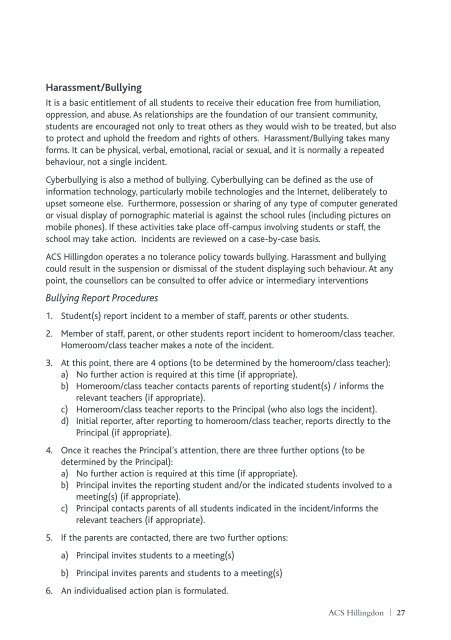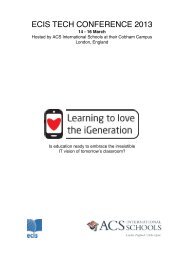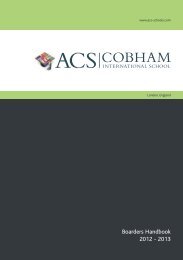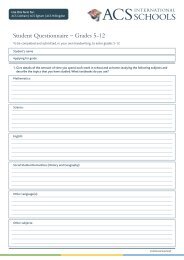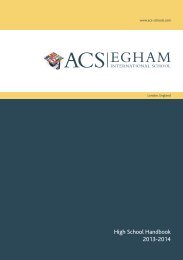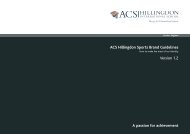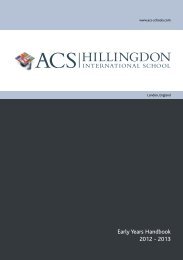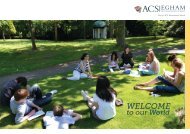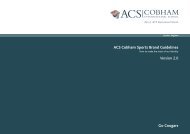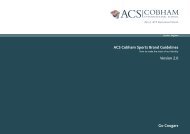10989 Student Handbook 06 - ACS International Schools
10989 Student Handbook 06 - ACS International Schools
10989 Student Handbook 06 - ACS International Schools
Create successful ePaper yourself
Turn your PDF publications into a flip-book with our unique Google optimized e-Paper software.
Harassment/Bullying<br />
It is a basic entitlement of all students to receive their education free from humiliation,<br />
oppression, and abuse. As relationships are the foundation of our transient community,<br />
students are encouraged not only to treat others as they would wish to be treated, but also<br />
to protect and uphold the freedom and rights of others. Harassment/Bullying takes many<br />
forms. It can be physical, verbal, emotional, racial or sexual, and it is normally a repeated<br />
behaviour, not a single incident.<br />
Cyberbullying is also a method of bullying. Cyberbullying can be defined as the use of<br />
information technology, particularly mobile technologies and the Internet, deliberately to<br />
upset someone else. Furthermore, possession or sharing of any type of computer generated<br />
or visual display of pornographic material is against the school rules (including pictures on<br />
mobile phones). If these activities take place off-campus involving students or staff, the<br />
school may take action. Incidents are reviewed on a case-by-case basis.<br />
<strong>ACS</strong> Hillingdon operates a no tolerance policy towards bullying. Harassment and bullying<br />
could result in the suspension or dismissal of the student displaying such behaviour. At any<br />
point, the counsellors can be consulted to offer advice or intermediary interventions<br />
Bullying Report Procedures<br />
1. <strong>Student</strong>(s) report incident to a member of staff, parents or other students.<br />
2. Member of staff, parent, or other students report incident to homeroom/class teacher.<br />
Homeroom/class teacher makes a note of the incident.<br />
3. At this point, there are 4 options (to be determined by the homeroom/class teacher):<br />
a) No further action is required at this time (if appropriate).<br />
b) Homeroom/class teacher contacts parents of reporting student(s) / informs the<br />
relevant teachers (if appropriate).<br />
c) Homeroom/class teacher reports to the Principal (who also logs the incident).<br />
d) Initial reporter, after reporting to homeroom/class teacher, reports directly to the<br />
Principal (if appropriate).<br />
4. Once it reaches the Principal’s attention, there are three further options (to be<br />
determined by the Principal):<br />
a) No further action is required at this time (if appropriate).<br />
b) Principal invites the reporting student and/or the indicated students involved to a<br />
meeting(s) (if appropriate).<br />
c) Principal contacts parents of all students indicated in the incident/informs the<br />
relevant teachers (if appropriate).<br />
5. If the parents are contacted, there are two further options:<br />
a) Principal invites students to a meeting(s)<br />
b) Principal invites parents and students to a meeting(s)<br />
6. An individualised action plan is formulated.<br />
<strong>ACS</strong> Hillingdon | 27


